Input interpretation

dimethyl sulfoxide
Chemical names and formulas
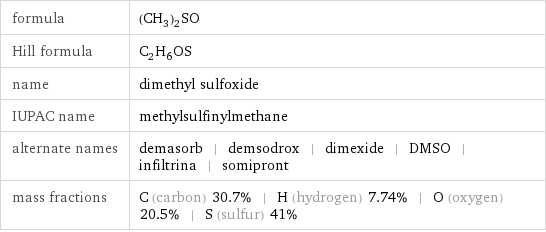
formula | (CH_3)_2SO Hill formula | C_2H_6OS name | dimethyl sulfoxide IUPAC name | methylsulfinylmethane alternate names | demasorb | demsodrox | dimexide | DMSO | infiltrina | somipront mass fractions | C (carbon) 30.7% | H (hydrogen) 7.74% | O (oxygen) 20.5% | S (sulfur) 41%
Lewis structure
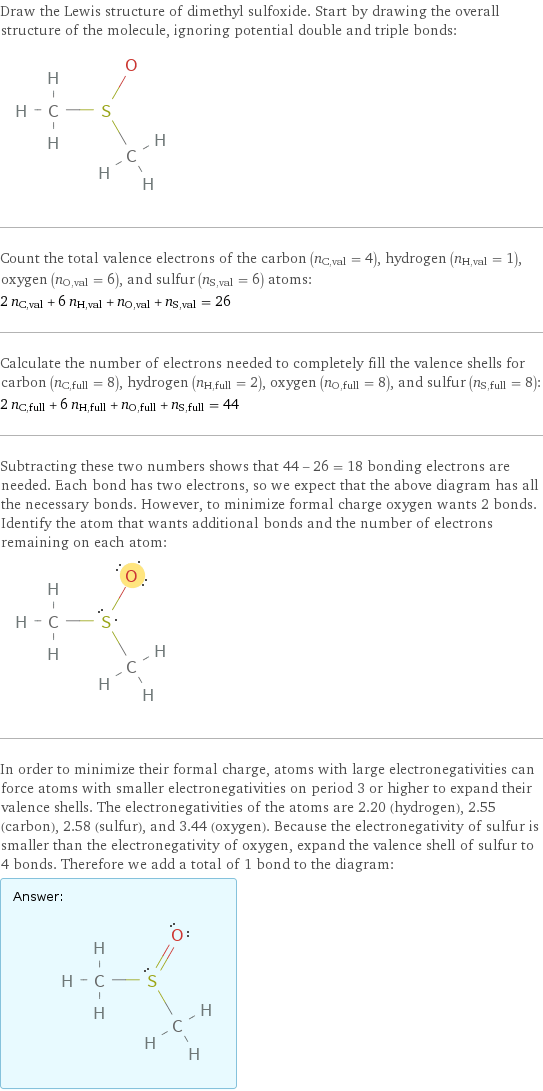
Draw the Lewis structure of dimethyl sulfoxide. Start by drawing the overall structure of the molecule, ignoring potential double and triple bonds: Count the total valence electrons of the carbon (n_C, val = 4), hydrogen (n_H, val = 1), oxygen (n_O, val = 6), and sulfur (n_S, val = 6) atoms: 2 n_C, val + 6 n_H, val + n_O, val + n_S, val = 26 Calculate the number of electrons needed to completely fill the valence shells for carbon (n_C, full = 8), hydrogen (n_H, full = 2), oxygen (n_O, full = 8), and sulfur (n_S, full = 8): 2 n_C, full + 6 n_H, full + n_O, full + n_S, full = 44 Subtracting these two numbers shows that 44 - 26 = 18 bonding electrons are needed. Each bond has two electrons, so we expect that the above diagram has all the necessary bonds. However, to minimize formal charge oxygen wants 2 bonds. Identify the atom that wants additional bonds and the number of electrons remaining on each atom: In order to minimize their formal charge, atoms with large electronegativities can force atoms with smaller electronegativities on period 3 or higher to expand their valence shells. The electronegativities of the atoms are 2.20 (hydrogen), 2.55 (carbon), 2.58 (sulfur), and 3.44 (oxygen). Because the electronegativity of sulfur is smaller than the electronegativity of oxygen, expand the valence shell of sulfur to 4 bonds. Therefore we add a total of 1 bond to the diagram: Answer: | |
3D structure
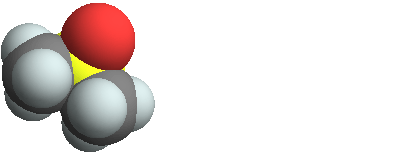
3D structure
Basic properties
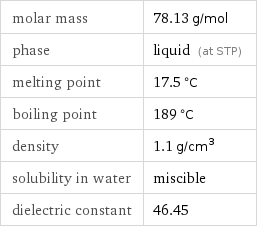
molar mass | 78.13 g/mol phase | liquid (at STP) melting point | 17.5 °C boiling point | 189 °C density | 1.1 g/cm^3 solubility in water | miscible dielectric constant | 46.45
Hydrophobicity and permeability properties

experimental LogP hydrophobicity | -0.7 predicted LogP hydrophobicity | -1.09 predicted LogS | -0.08
Basic drug properties

approval status | approved | small molecule drug categories | non-narcotic analgesic | cryoprotective agent | free radical scavenger | solvent dosage forms | intravesical: solution | topical: solution

brand names | decap | deltan | demasorb | demavet | demeso | demsodrox | dermasorb | dimexide | dipirartril-tropico | dolicur | doligur | domoso | dromisol | durasorb | gamasol 90 | hyadur | infiltrina | kemsol | rimso 50 | sclerosol | somipront | syntexan | topsym
Liquid properties (at STP)
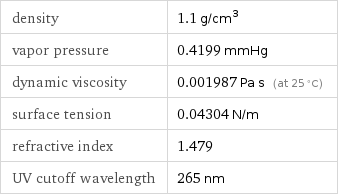
density | 1.1 g/cm^3 vapor pressure | 0.4199 mmHg dynamic viscosity | 0.001987 Pa s (at 25 °C) surface tension | 0.04304 N/m refractive index | 1.479 UV cutoff wavelength | 265 nm
Units
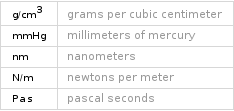
Thermodynamic properties

specific heat capacity c_p | liquid | 1.958 J/(g K) molar heat capacity c_p | liquid | 153 J/(mol K) specific free energy of formation Δ_fG° | liquid | -1.279 kJ/g molar free energy of formation Δ_fG° | liquid | -99.9 kJ/mol specific heat of formation Δ_fH° | gas | -1.937 kJ/g molar heat of formation Δ_fH° | gas | -151.3 kJ/mol molar heat of vaporization | 40.8 kJ/mol | specific heat of vaporization | 0.522 kJ/g | molar heat of combustion | 1715 kJ/mol | specific heat of combustion | 21.95 kJ/g | molar heat of fusion | 14.37 kJ/mol | specific heat of fusion | 0.1839 kJ/g | (at STP)
Chemical identifiers

CAS number | 67-68-5 Beilstein number | 506008 PubChem CID number | 679 PubChem SID number | 13325 SMILES identifier | CS(=O)C InChI identifier | InChI=1/C2H6OS/c1-4(2)3/h1-2H3 InChI key | IAZDPXIOMUYVGZ-UHFFFAOYAR RTECS number | PV6210000 MDL number | MFCD00002089
NFPA label

NFPA label
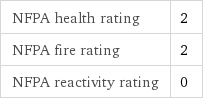
NFPA health rating | 2 NFPA fire rating | 2 NFPA reactivity rating | 0
Safety properties

flash point | 85 °C autoignition point | 300 °C lower explosive limit | 1.8% (concentration in air) upper explosive limit | 63% (concentration in air)